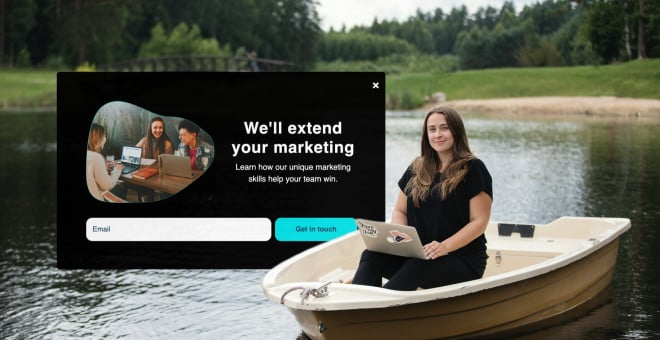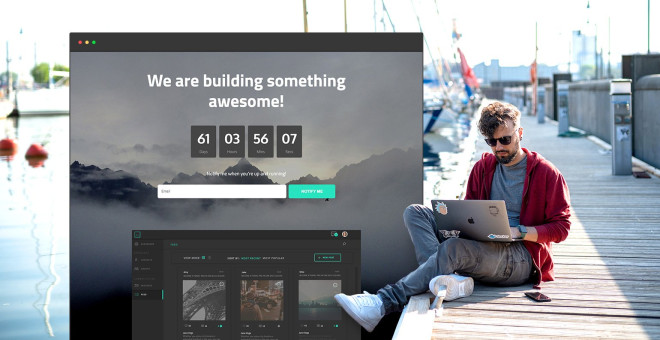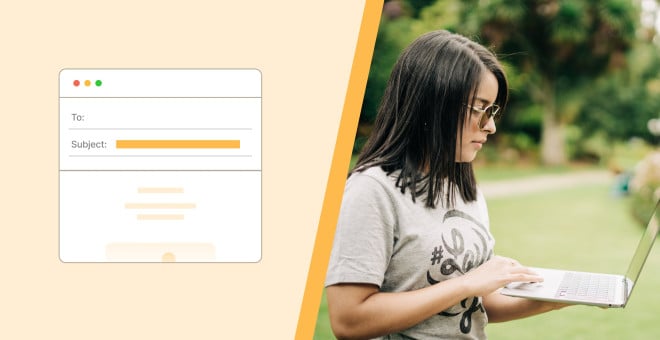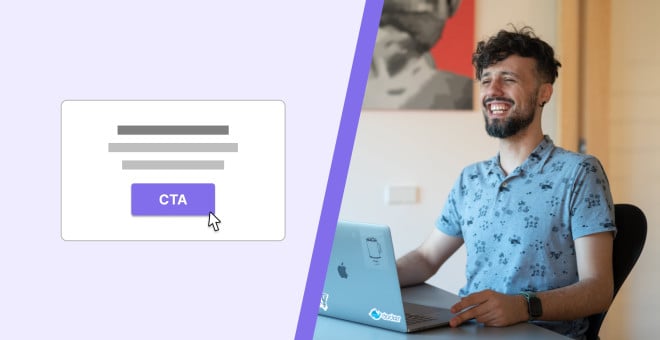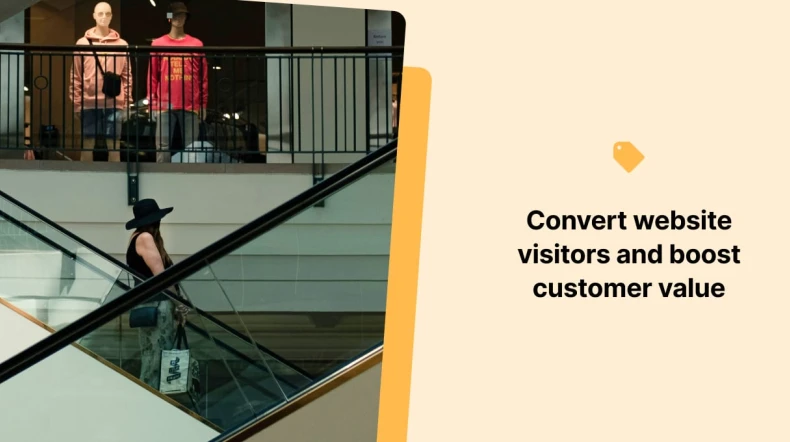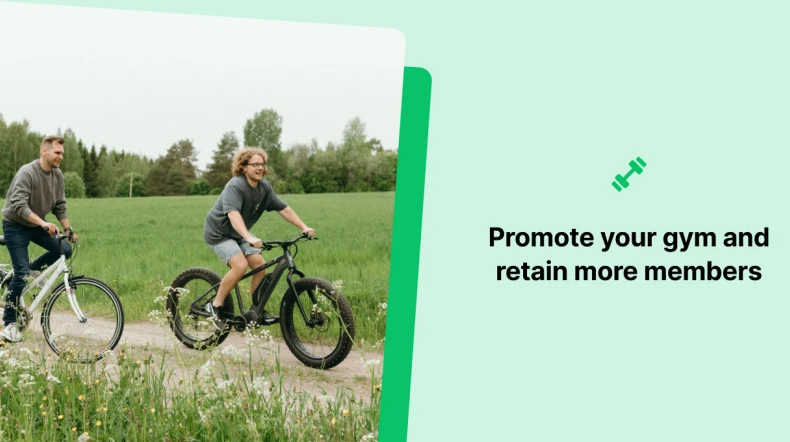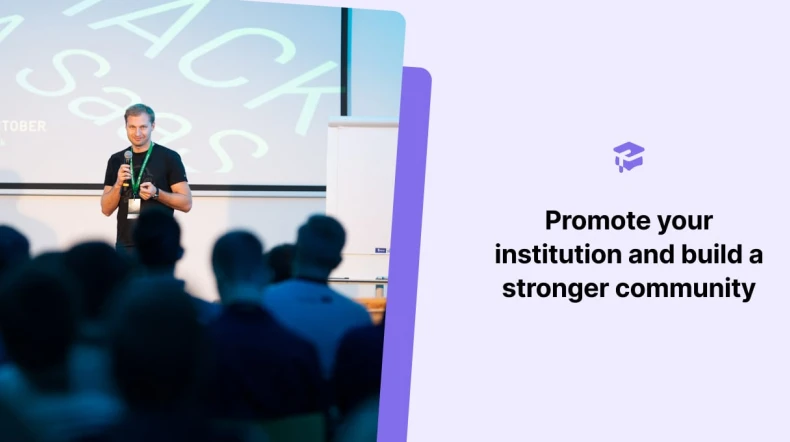The podcast email marketing guide to grow your audience and get famous
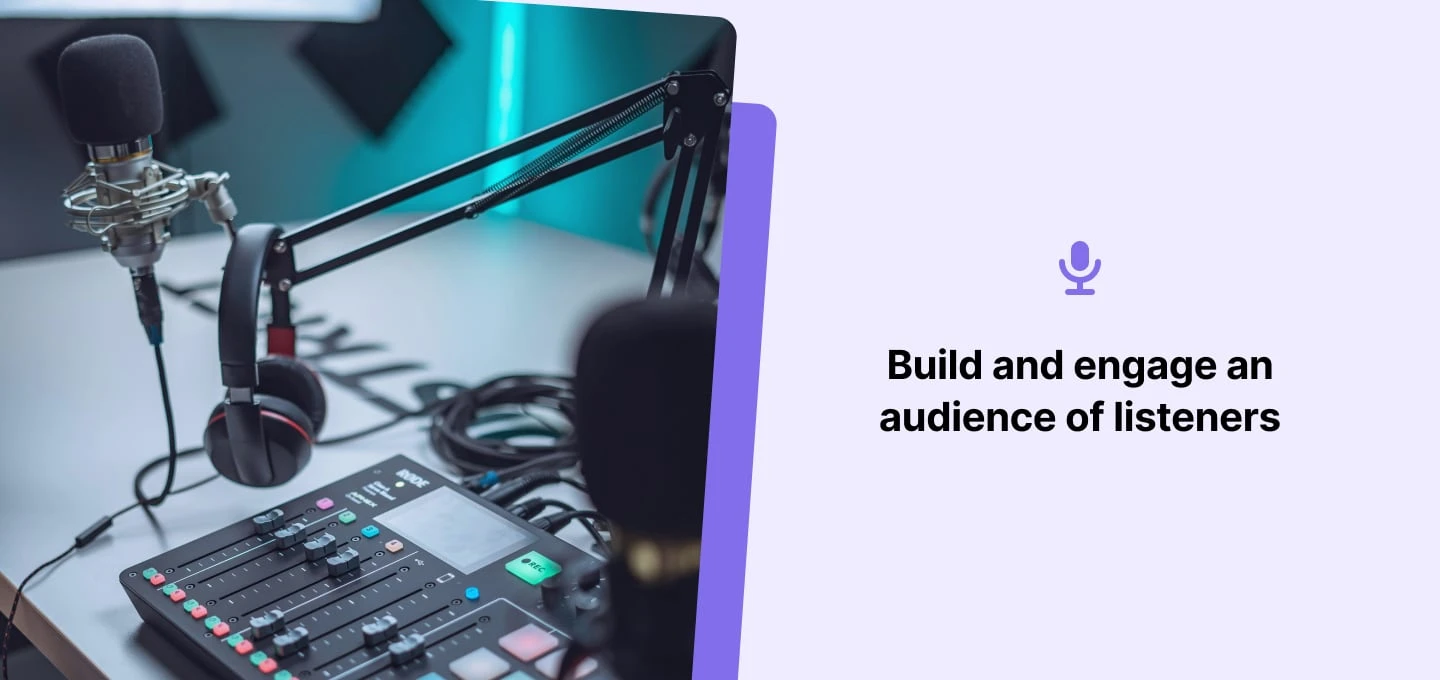
Wait… is that you, the famous podcast host?! Even if you’re feeling a bit shy reading that sentence, just know that it can be you!
By promoting your podcast correctly, you can build an audience of dedicated, raving listeners and become a familiar voice in the online podcast world.
In this guide, we’ll focus on how to grow your podcast fanbase using email marketing.
You’ll learn how to craft an email marketing podcast strategy that works, build tight relationships with listeners and gain new fans. You’ll feel inspired by MailerLite customers that run their own podcasts, as we show you examples of what their email campaigns look like.
Why using email marketing for podcasts is a no-brainer
When you host a podcast, you’ll be talking to your listeners directly. But what happens afterward?
Email marketing is the perfect tool to bridge the gap between episodes and keep listeners engaged. Your email campaigns can add more depth to your podcast. Plus, you can use them to grow your fanbase.
When people sign up for your email list, the anonymous listener becomes a subscriber with a name that you can learn more about. Through direct contact, you can get to know their interests and opinions, and by analyzing their email engagement you’ll know what resonates (and what doesn’t).
With podcast email marketing you can:
Have two-way conversations
Build a community and strengthen relationships
Gather feedback, suggestions and insights from your audience
Use email reports for online business optimization
Elaborate or follow-up on topics after a podcast episode
Use lead magnets to grow your listener base
Automate messages to lessen your workload
Re-engage listeners through win-back email campaigns
Earn money by promoting paid services/products or using advertising
Offer sponsors or advertisers another advertising medium
Crafting your email marketing podcast strategy
Let’s get down to business and start working on your podcast email marketing strategy!
Step 1. Define your goal
You can use your email campaigns for a variety of reasons—from notifying people about your latest episodes to selling products or memberships.
Every email campaign should also aim to strengthen relationships and engage your audience, but specific goals have slightly different approaches.
For example, episode-release emails are purely informative, whereas campaigns promoting merchandise or memberships need a sales approach. For the latter, you’ll need to think of an email sequence that offers readers value before they’re asked to buy from you.
Your goal helps you come up with the bigger picture, and how all your digital marketing campaigns work together to get you from A to Z.
Step 2. Choose an email marketing service
An email marketing tool will help you create and automate newsletters, segment your audience and analyze your results.
When choosing your email service, it’s good to keep certain things in mind:
What’s the editor like (e.g. drag & drop)? Can you design newsletters exactly as you want?
Can you easily engage people through email (e.g. asking for feedback using survey blocks)?
Are there marketing automation or RSS-feed possibilities (e.g. to automatically notify subscribers about the latest episodes)?
Do the reports provide enough information to analyze your efforts?
Are integrations for your podcast platform available (e.g. Podbean, Zapier)?
Can you sell digital products or subscriptions through your landing pages?
And then, of course, it’s good to compare prices to see which email software fits your budget and provides the best value for money.
Want to give MailerLite a go?
Your Forever Free plan includes access to essential features like automation and landing pages.
Step 3. Create subscriber signup forms
To grow your audience, people need to know about your podcast. You can promote your podcast with pop-ups and signup forms on your website.
If you’ve chosen MailerLite as your email service in the last step (excellent choice!), you’ll have a variety of signup forms to pick from. For pop-ups, you can easily switch between full-screen pop-ups, sliders and floating bars. Read more about the possibilities below.
To stimulate list growth you can use email lead magnets (incentives for subscribers to sign up).
Examples are freebies like an exclusive podcast episode, online course discount, coaching call, downloadable list or anything else that’s valuable for your podcast listeners. Click for an example of a lead magnet email sequence.
If you’re curious about how to turn your signup form into a lead-capturing machine, head over to this blog article.
Step 4. Promote your podcast to email subscribers
The best way to promote your podcast is by using a dedicated landing page. If you don’t have a website yet, you can create one using MailerLite’s website builder, or use our landing page builder to create a single page.
The key elements of a promotional landing page:
Value proposition (explaining why people should listen to your podcast)
A single call to action (such as “Sign up for the newsletter”)
Signup form
Episode examples (directly embedded via HTML or using images/redirect buttons)
Depending on your page goal, you can insert web page elements like:
Newsletter archive
Listener reviews
Feedback survey
Tip: If you use MailerLite, you’re super flexible when it comes to your podcast landing page design. You’ll work with drag & drop, so you don’t need any coding skills (it’s super easy)!
Click below to discover what you can expect from our builder.
Step 5. Integrate social media and email marketing
Social media is great for promoting your podcast (both organically and paid) and growing your online business. However, it’s not the best strategy for building long-lasting connections.
With ever-changing algorithms and promotional content influencing people’s feeds, you can never be sure if your podcast content is actually seen by your followers. That’s where email marketing comes in.
When promoting your podcast on social media, redirect people to your signup landing page—not directly to Apple, Spotify, Stitcher, etc. By collecting subscribers through your pages, you’ll own the email addresses. If you switch podcast services or change your social media pages, you take your audience with you.
Our detailed guide on how to make email and social media marketing work together for good shows you all the steps to growing your email list and expanding your reach.
Email marketing and social media are two of the most powerful marketing tools for growing your audience and building your brand.
Podcast email campaign content ideas
Your email campaign is a blank canvas to fill with content that’s valuable for readers and nurtures relationships. Episode reminders are an example of valuable email content, but there are many more topics you can talk about within your email campaign.
Content ideas for podcast email campaigns:
Show notes
Behind-the-scenes footage of the production process
Personal thank you message
Recap of the podcast show
Discussion points
Feedback survey to gather insights or new ideas
Listener responses
Reminder of new releases
Personal or industry news
Aftershow content (e.g. elaborating on topics or showing parts that didn’t make it in the podcast)
Promotional offers
Merchandise or products
Celebrating milestones or special moments
Event invites
Newsletter-only offers
Further reading material on topics/references discussed in the podcast
MailerLite customer and podcaster, Heather from Don’t Mom Alone, shows this variety in her email newsletter. In the newsletter, you’ll see content elements like the show notes, upcoming events and a feedback questionnaire to help the host gather new podcast episode ideas.
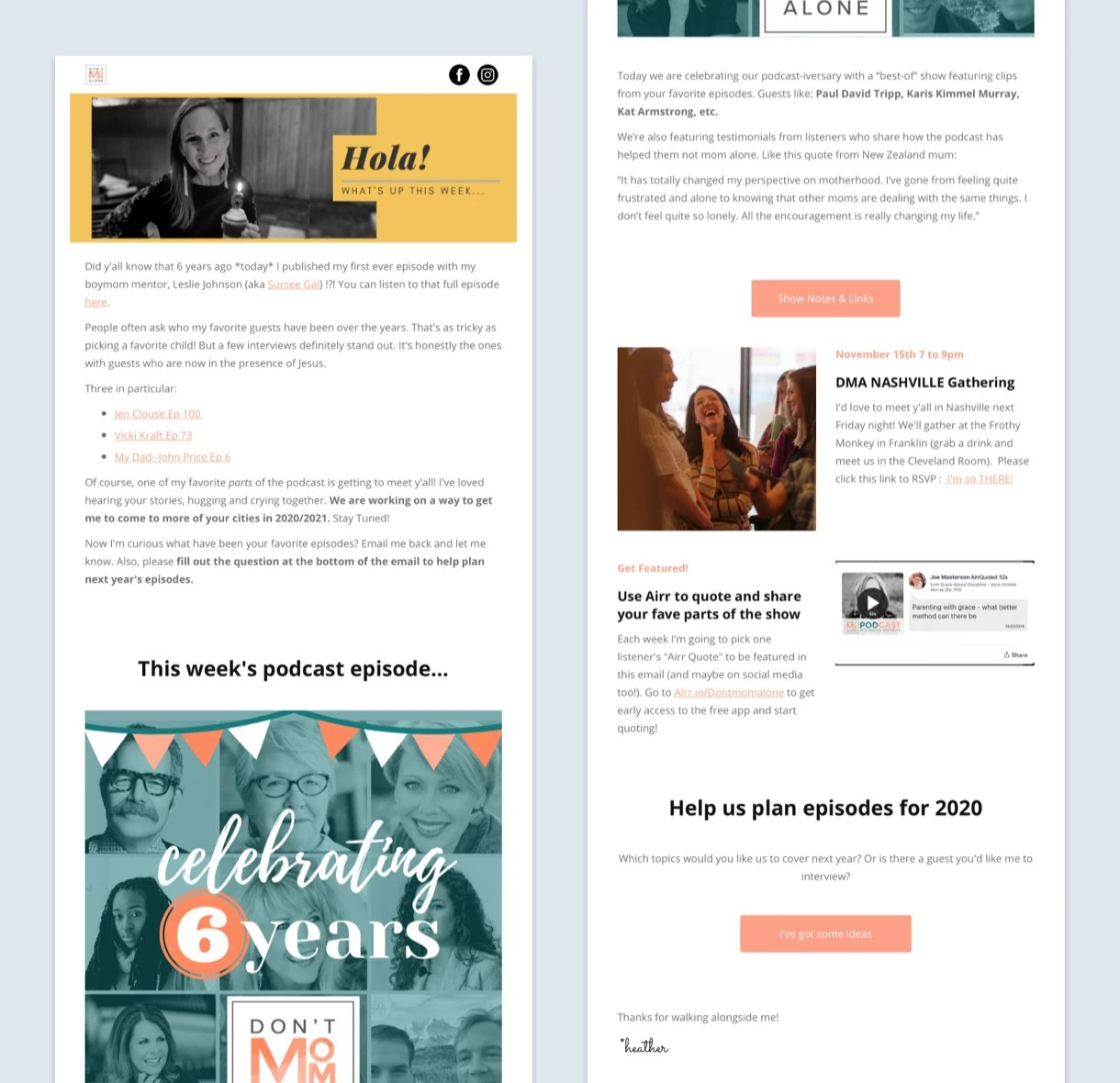
Key elements of your podcast newsletter
1. Craft a good subject line
Every email campaign starts with an enticing subject line. It’s the sentence (or the few words) that make a reader decide whether to click or not, and therefore influences your email open rate. If you’re curious about what practices can be used to craft a good subject line, click below.
2. Choose the email content type
Once your email is opened, the content is the first thing readers will see. Keep your emails and podcast aligned by writing in the same way as you speak, and using images and colors that fit your brand.
When creating your podcast email campaign, you can opt for a text-only email or design your newsletter layout.
Text-only email
When you use MailerLite, text-only emails are created with the rich-text editor. Text-based emails put all the focus on the storytelling and tend to feel more personal. However, the design options are very limited.
A text-only email could look like the one below, an example from Unlocking Bryson’s Brain’s podcast host Keith.
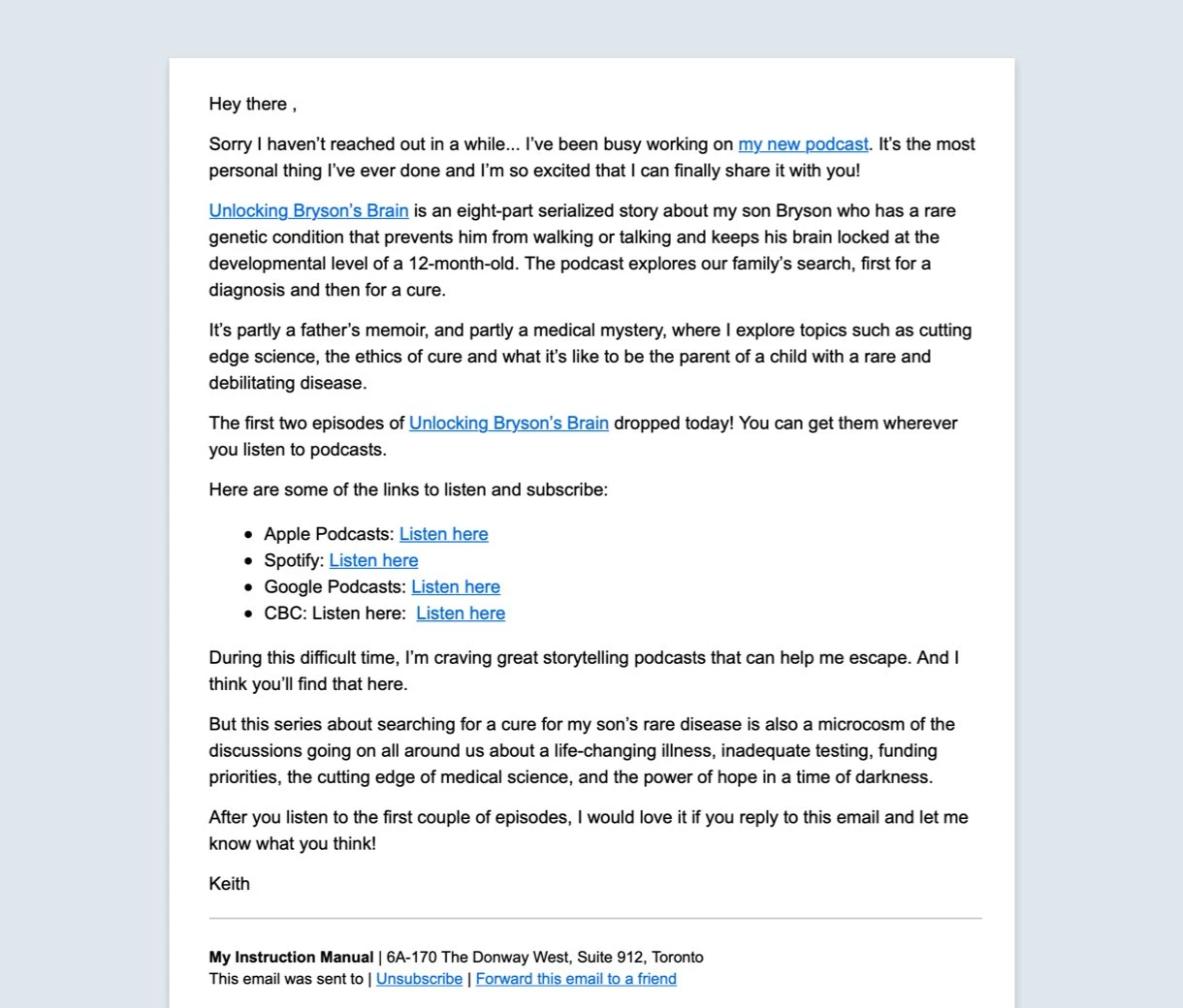
Designed email
When designing emails with a drag & drop, aka What You See Is What You Get (WYSIWYG) editor, you’ll have a lot more flexibility and options. You can use content blocks to build an email newsletter from scratch or modify predefined email templates.
If you’re new to creating email templates or want to improve your design skills, we’ve created a guide teaching you the best approaches for layout and composition in email design.
3. Add the email header
The email header is a great way to start your email, both from a design aspect as well as for brand recognition. The header can simply be your podcast logo or artwork for that specific newsletter topic.
Don’t forget to add the ALT text for the email header image, as well as all other images. This descriptive line serves as a backup to convey your message in case your images aren’t shown and helps people with a reading disability to understand your message.
4. Insert a clear call to action
In each email, make sure to add an enticing call to action (CTA). Ideally, you have one goal per campaign and a CTA that clearly states that goal (e.g. “Visit merch shop” or “Listen to episode”).
Learn more about how to create a converting CTA below.
An example of a clear CTA comes from MailerLite customer and podcaster Joe from Towel & Basin. The text link pops because of the contrasting color and the image of the podcast episode supports the CTA.
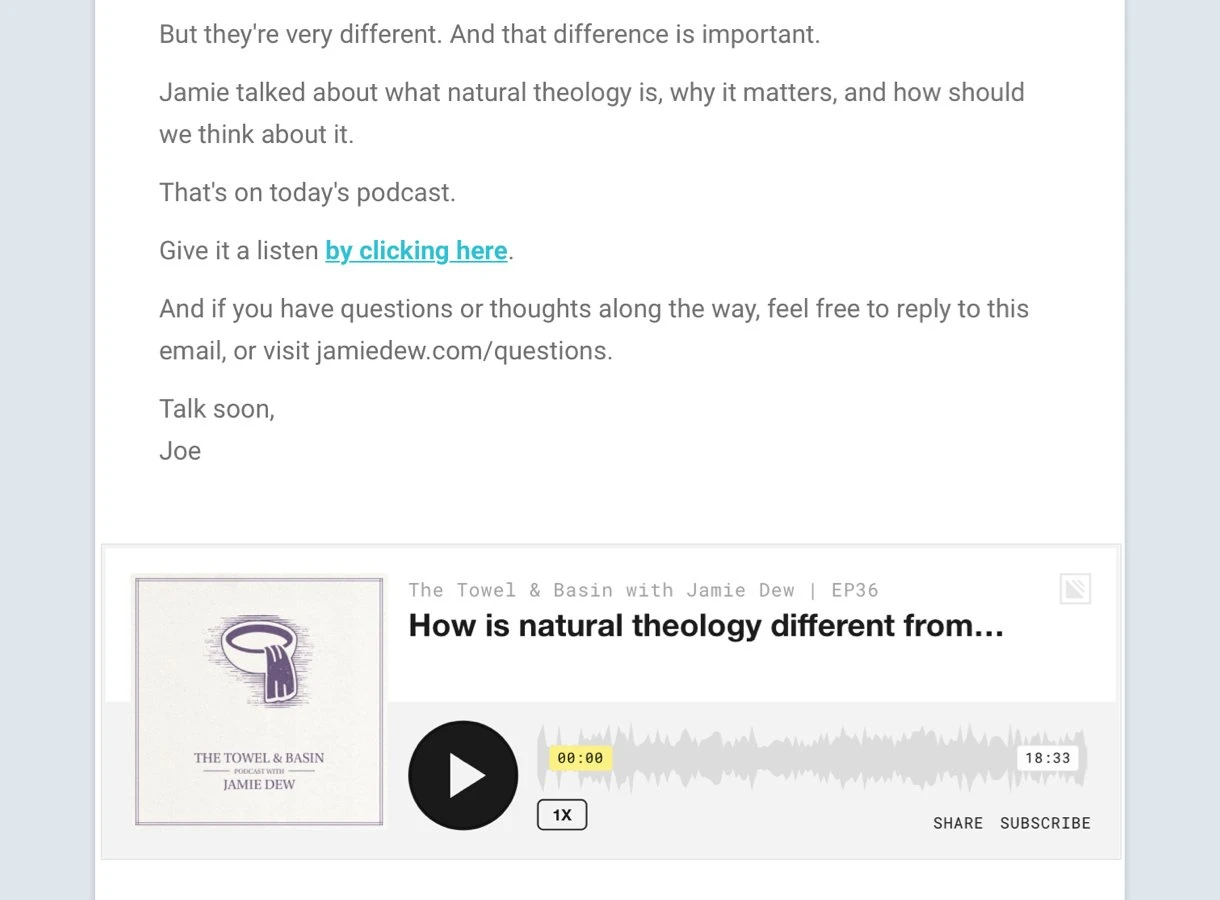
5. Embed social and listening links
For podcast emails, make sure to add your social channels in the email, as well as important links such as your iTunes, Spotify or Stitcher URLs. This way readers can easily find your podcast online. The most common places to insert these icons are the email footer or header.
In this podcasting newsletter from Mommifaceted, blogger Rachel inserted her social icons directly under the email header for maximum visibility.

The podcast newsletter below from inflowradio is a good example of how to use image buttons to promote your different listening channels.
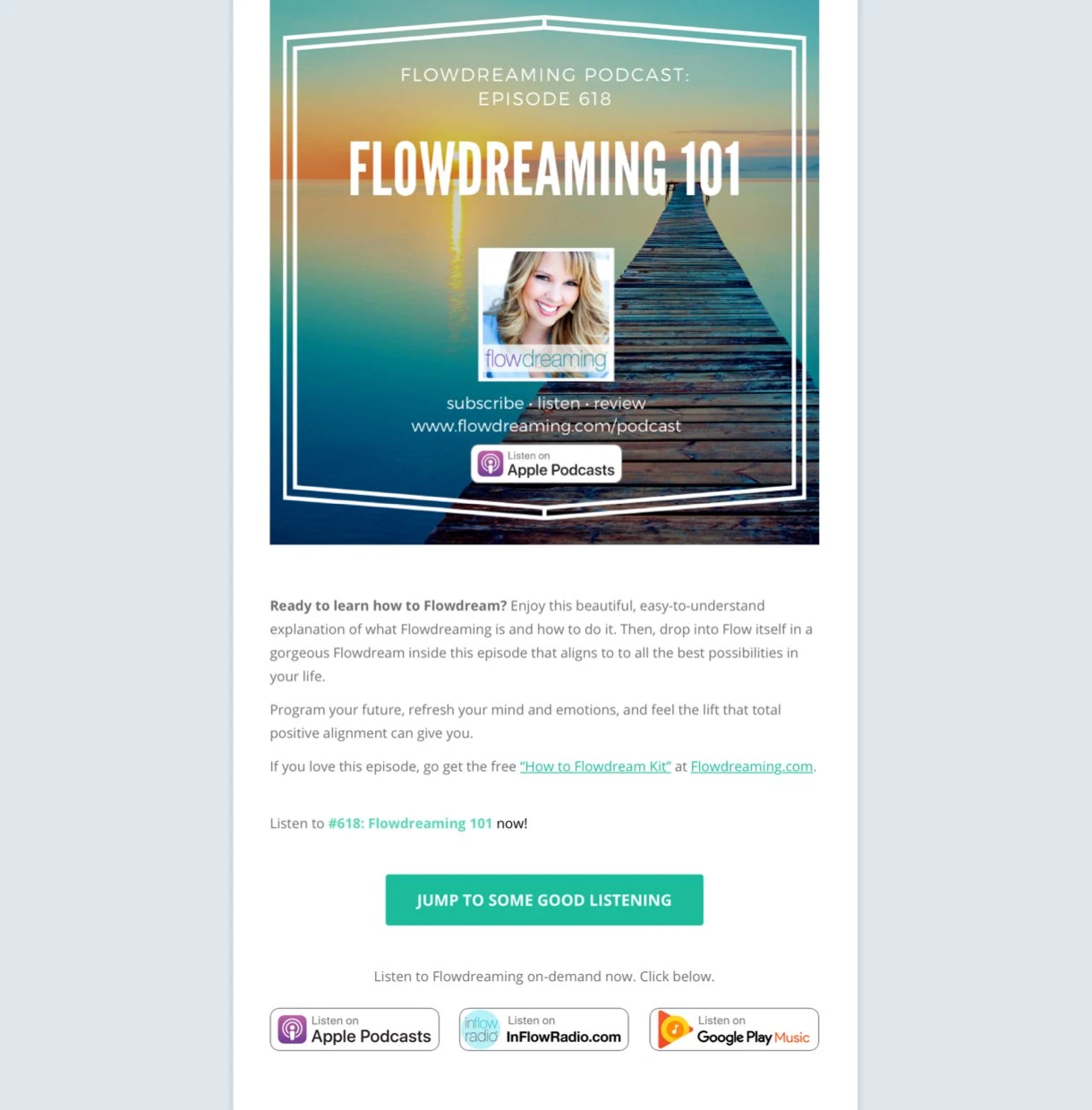
6. Be clear if it’s sponsored content
Many podcast hosts work with sponsors and advertisers to monetize their podcast. When you insert a message from an advertiser into your newsletter, make sure readers can easily spot the difference between your organic and paid content. This helps to maintain your authenticity and trustworthiness.
Podcasts newsletter examples from MailerLite customers
Emma Lemke
Business coach Emma Lemke shows readers directly what her newsletter is about using a beautifully designed email header. To excite readers, she quickly notes what’s discussed in the episode. The CTA buttons make it easy to navigate to the listener’s preferred listening platform.
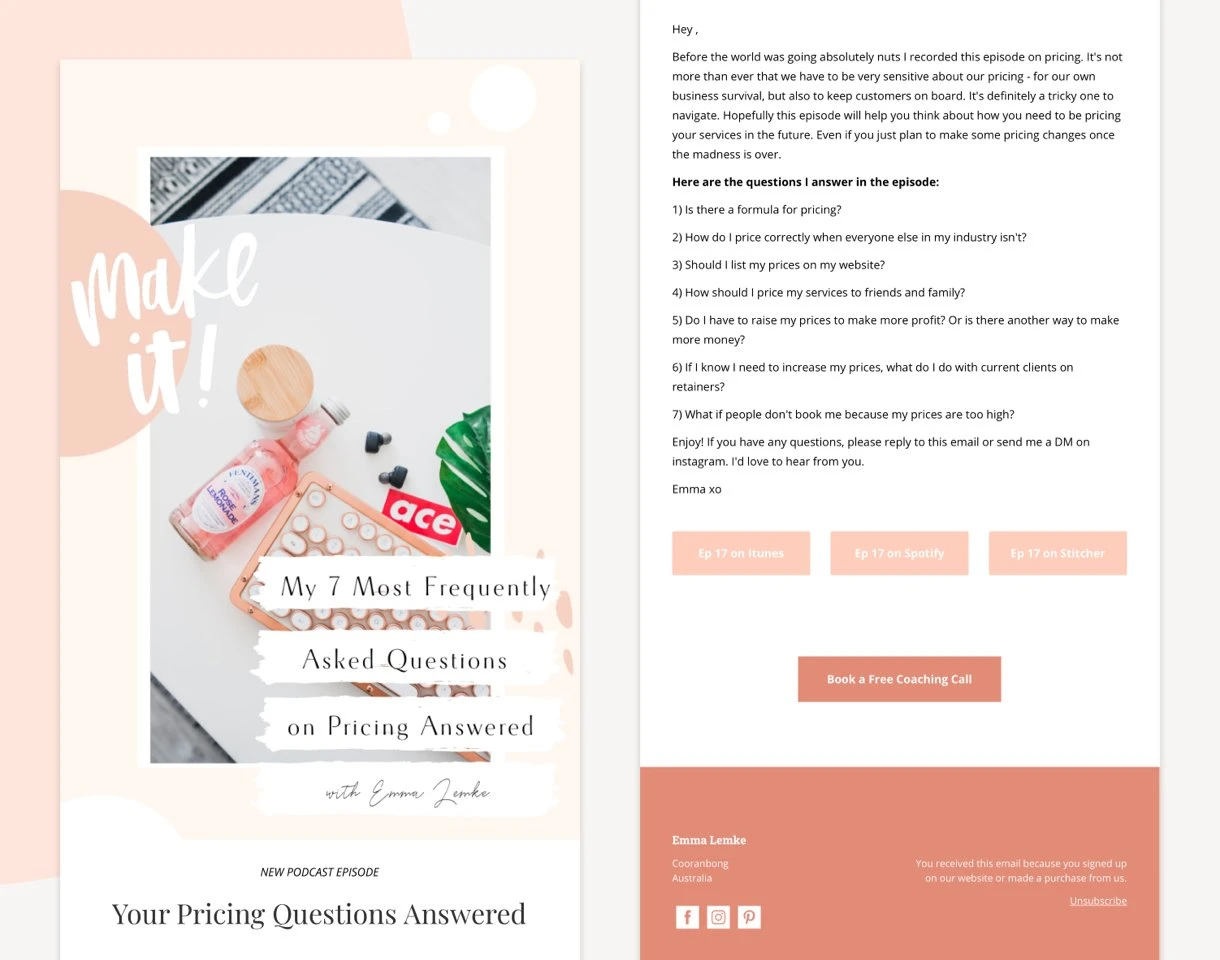
In other newsletters, she promotes her latest podcast episodes with a content block that looks like this:
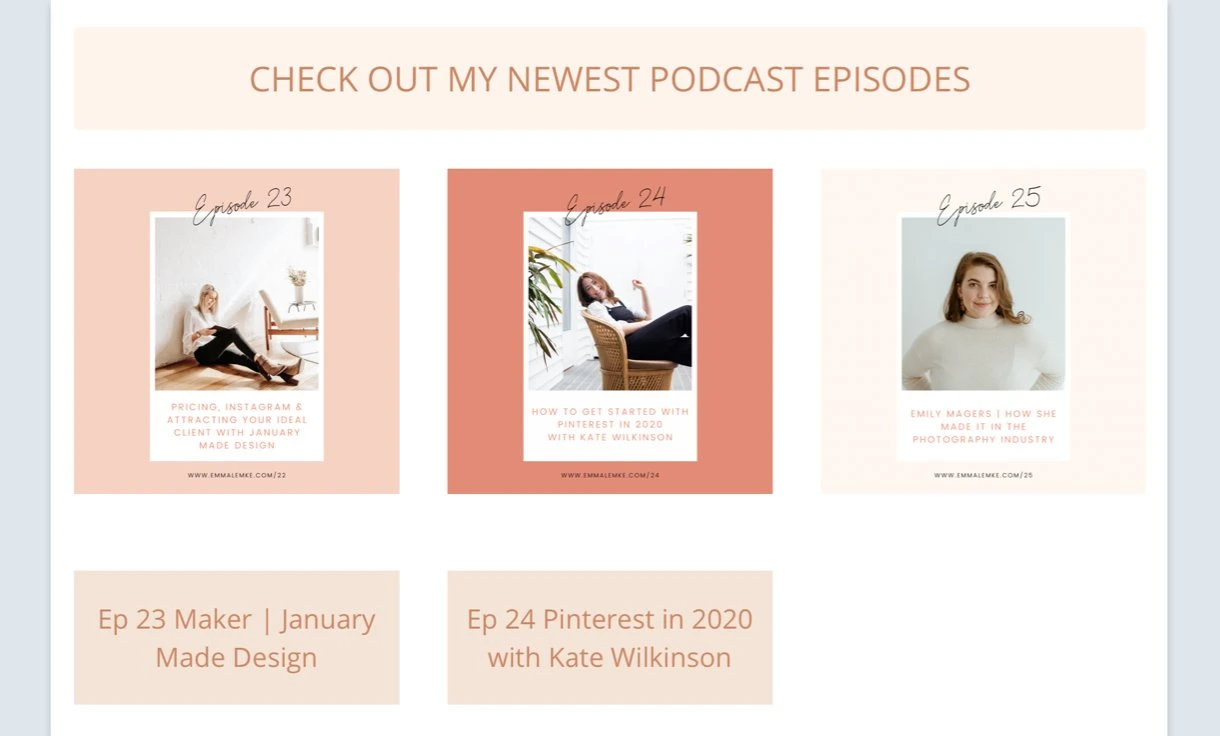
Furthermore, Emma is a perfect example of an email marketer that gets creative using the many content blocks available.
In the example above, she uses a newsletter background
In this newsletter, she implemented a countdown timer
In this email, you can see the video block in action
In this podcast newsletter, she shows how a well-designed email header can make your layout looks awesome
School's Over...Now What?
In this podcast, Shawn Anthony guides school dropouts and former and current students to find their path to success. To monetize his podcast, Shawn uses membership platform Patreon.
The email copy below is a good example of how to convince listeners to become paying fans. The text is authentic and the star bullet points make it clear what members can expect. The header image showing the host himself makes the email more personal and emphasizes that your investment goes towards one human being, not a corporate company.
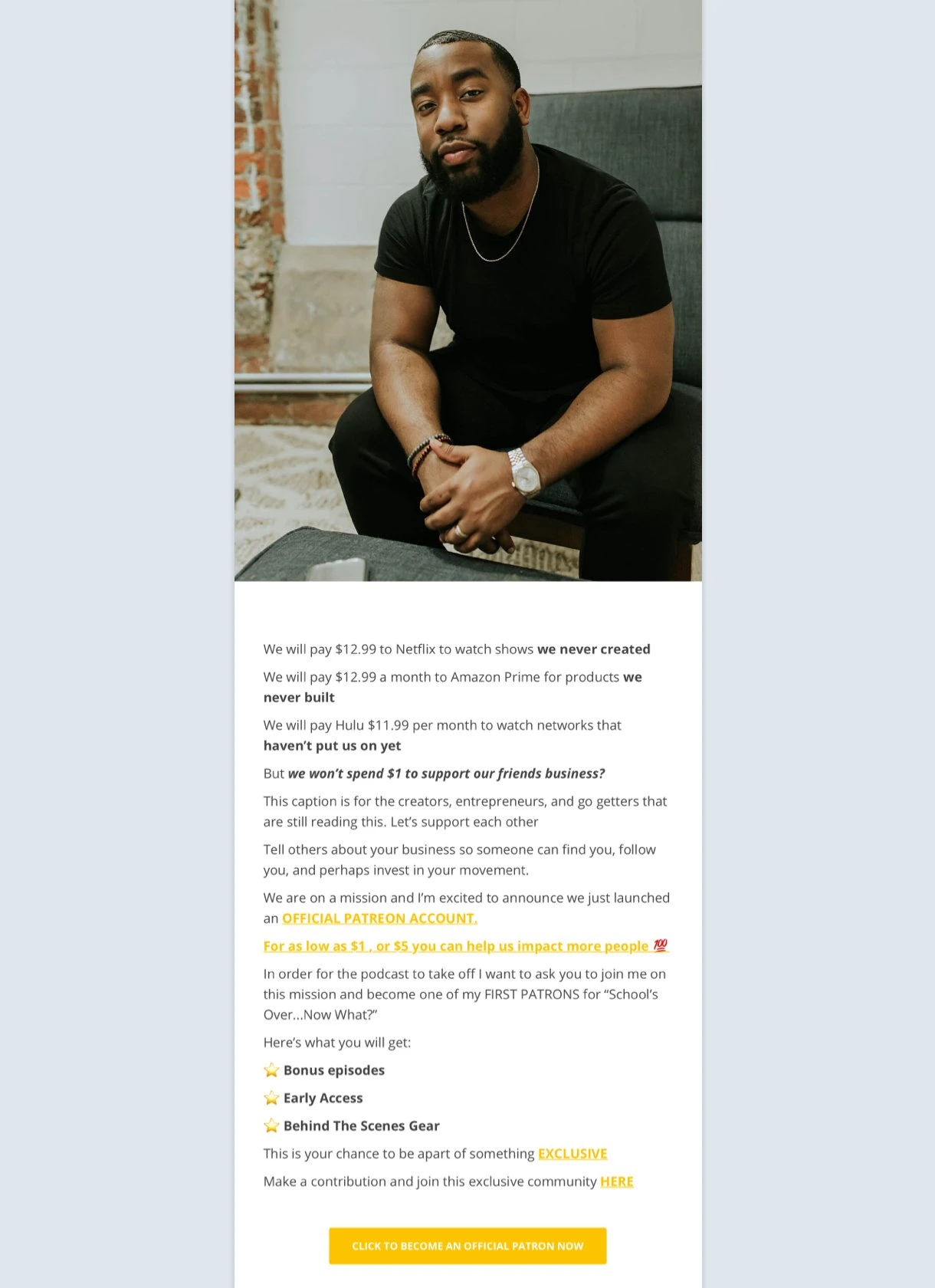
Next Stage Radicals
Open learning community Next Stage Radicals is a great example of adding depth to their podcast using email marketing.
Each email starts with a personal note from the podcast host. Then the podcast interviewee answers a couple of questions, followed by CTA buttons to listen to the podcast (and other relevant resources). The favorite section is a fun way to promote previous podcasts and other content.
All the email content gives the reader additional value and complements what is shared in the podcast episode.
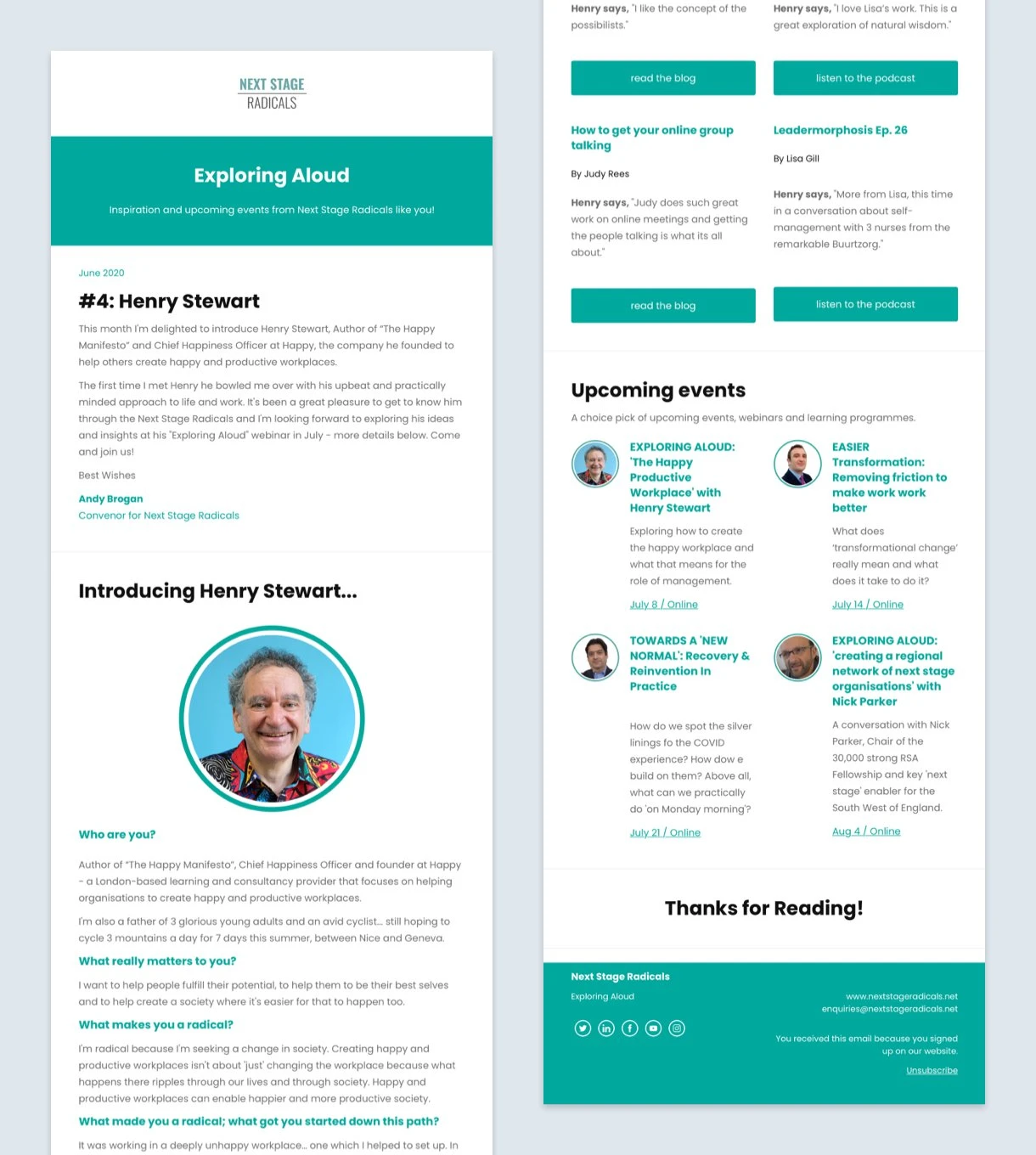
Reyna Marrufo
This motivational podcast on overcoming adversity by host Reyna Marrufo is a good example of what content a podcast newsletter should contain. The text introduces the episode’s guest and explains what listeners will learn. Then all relevant social and listening links are mentioned.
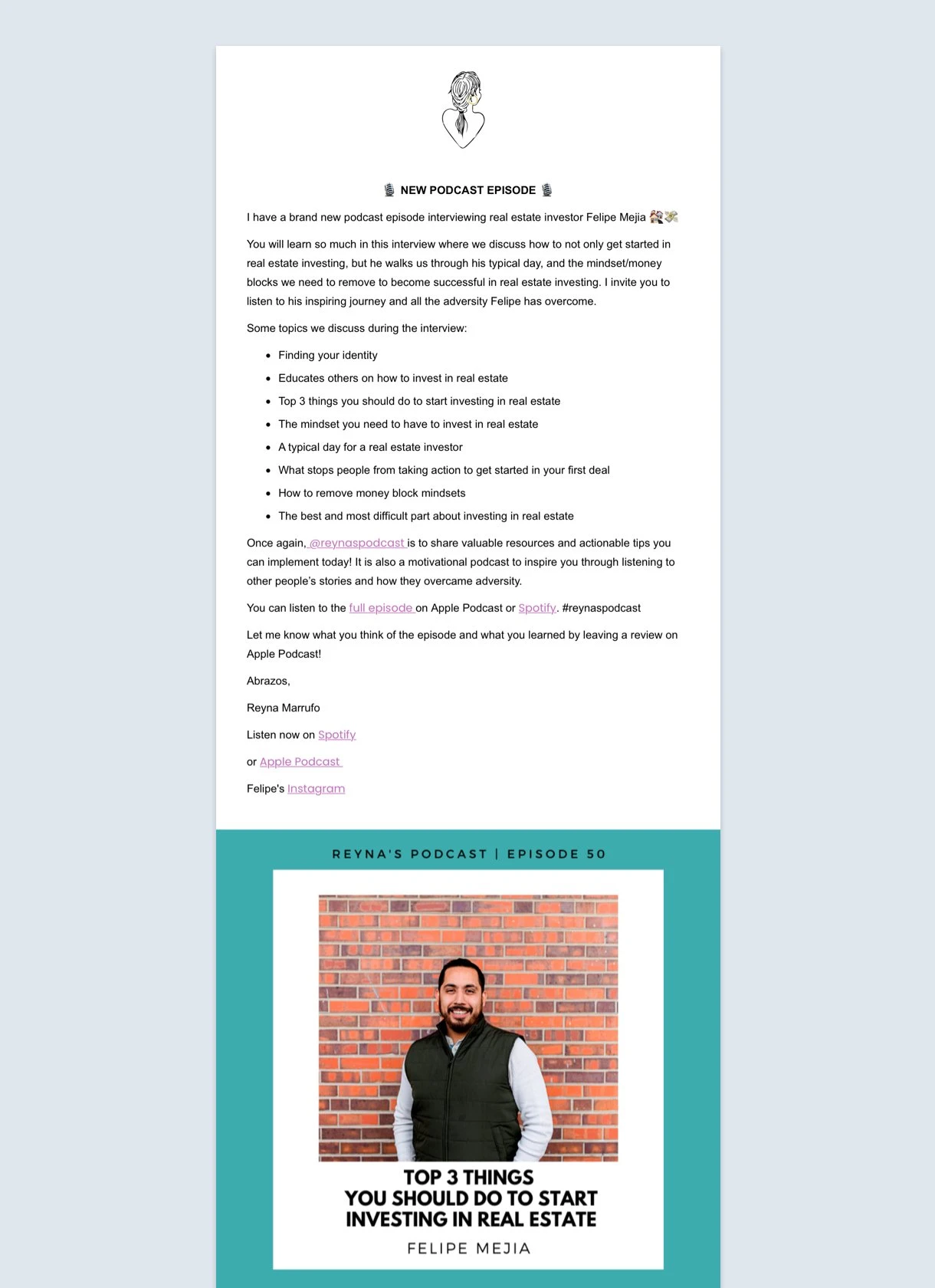
Reyna places the podcast episode artwork below the text, whereas Emma Lemke has it positioned at the top. Variations like these are great to test using the email A/B testing option. Create two different versions of the email content and then see if this influences the email click-through rate.
Startup Playbook
Rohit Bhargava chooses a slightly different, and very engaging path for his podcast—he hosts live podcasts! In his emails, guests are introduced beforehand and subscribers are motivated to sign up for the live interview recording. This approach is great for community building and offers listeners the opportunity to be part of the podcast.
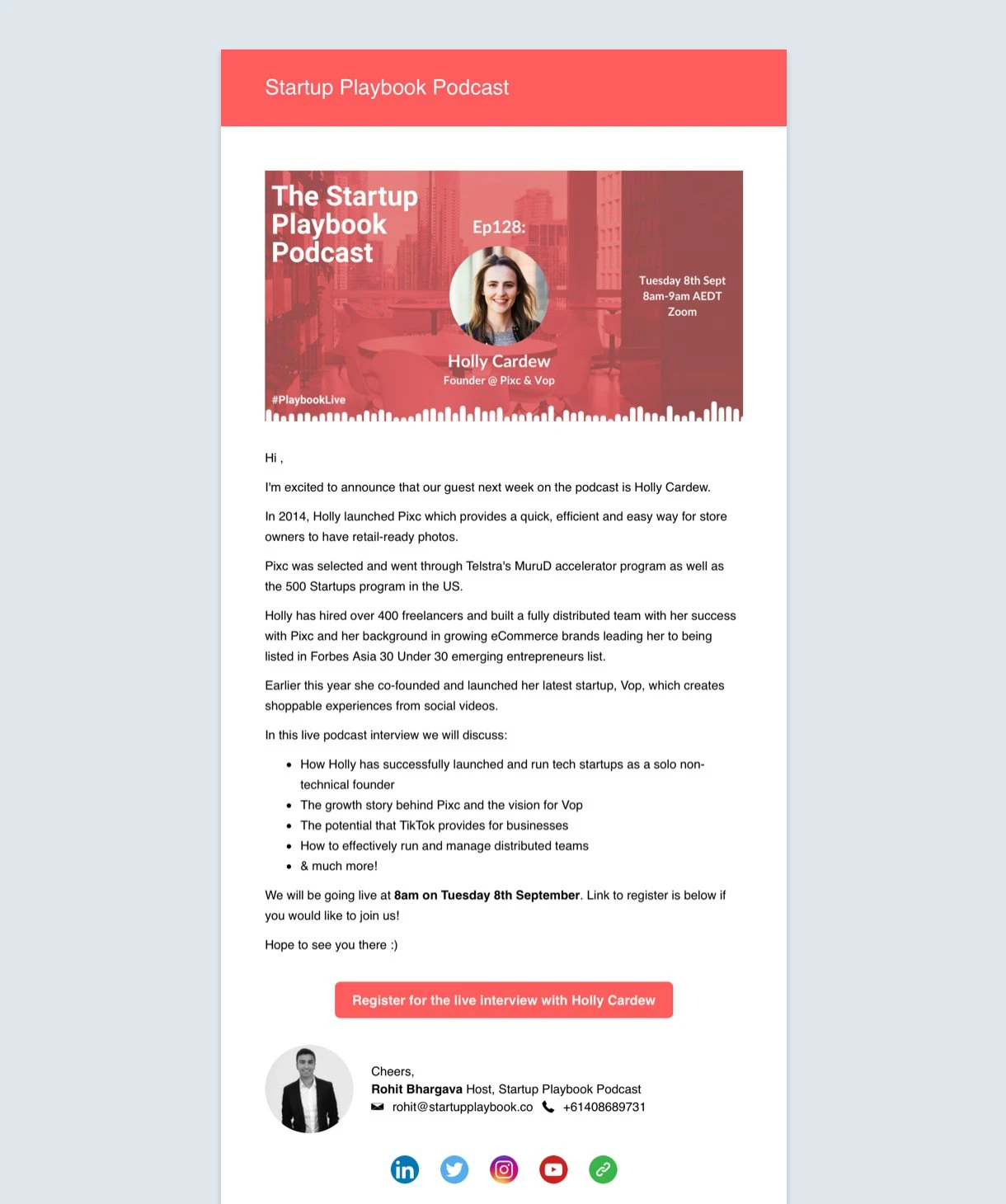
Curious to see more podcast newsletter examples?
Our last customer example, Podcast Review, delivers five podcast recommendations straight to people’s inboxes every Wednesday (sign up here). Their email campaigns are a great way to discover new listening material and find other podcasters with newsletters to sign up for.
Below is an example of what their podcast newsletter looks like.
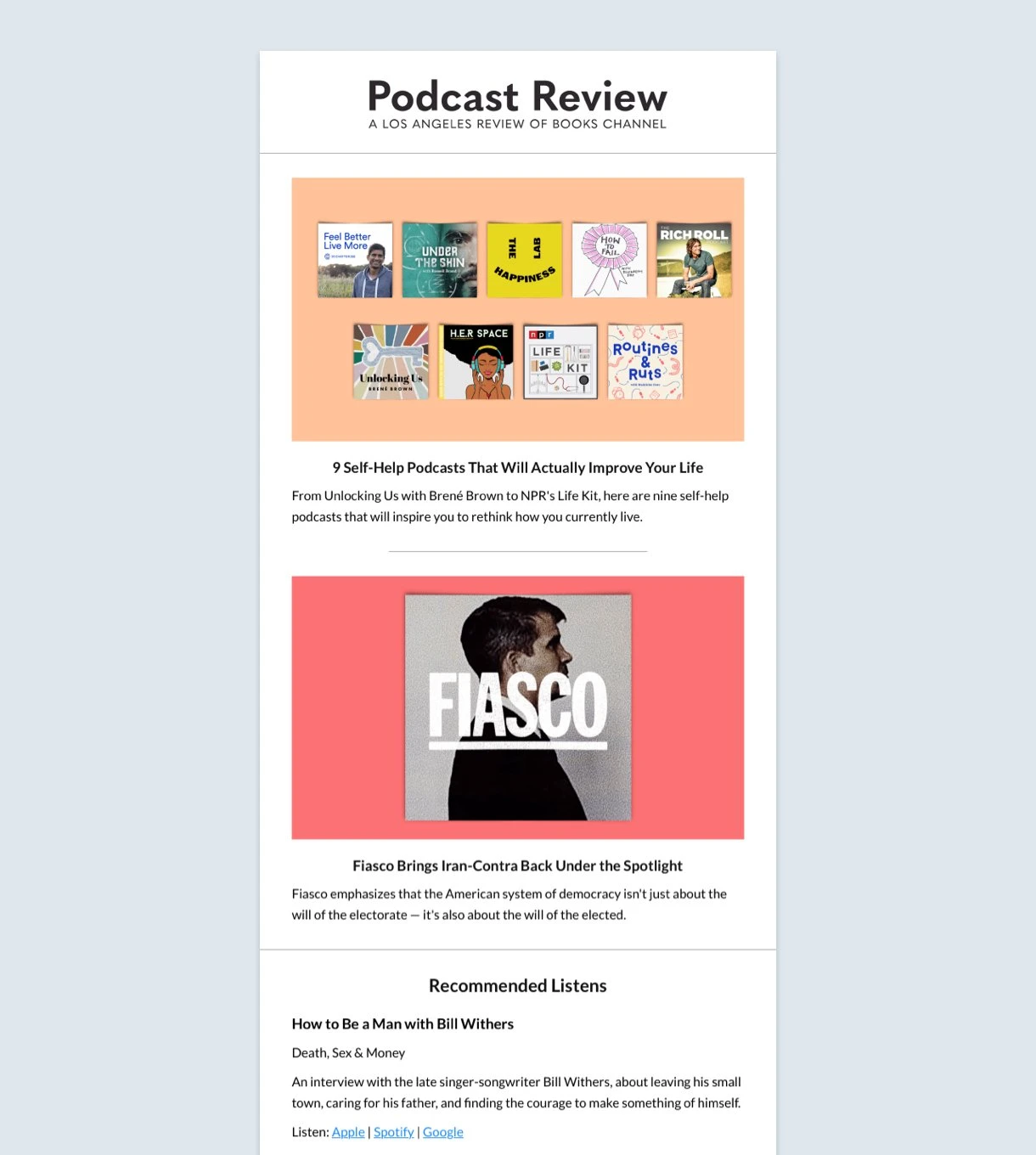
How to get the most out of email marketing for podcasts
Sending regular email campaigns is one thing, but there’s so much more you can do with podcast email marketing. We’ll share our three favorite email marketing tips below.
Marketing tip 1. Send automated welcome emails
Though often overlooked, welcome emails are the type of marketing automation campaigns you can’t miss.
On average, welcome email campaigns enjoy four times the open rate and five times the click-through rate over standard email marketing campaigns. Since podcast email marketing is heavily based on building relationships with listeners, a welcome email is a great place to start.
In your welcome message, introduce yourself (the host) and your podcast. Tell subscribers what to expect from your emails and share some podcast episodes readers can start listening to. Click here for a great example from Luvvie Ajayi Jones, who hosts a podcast called Rants & Randomness.
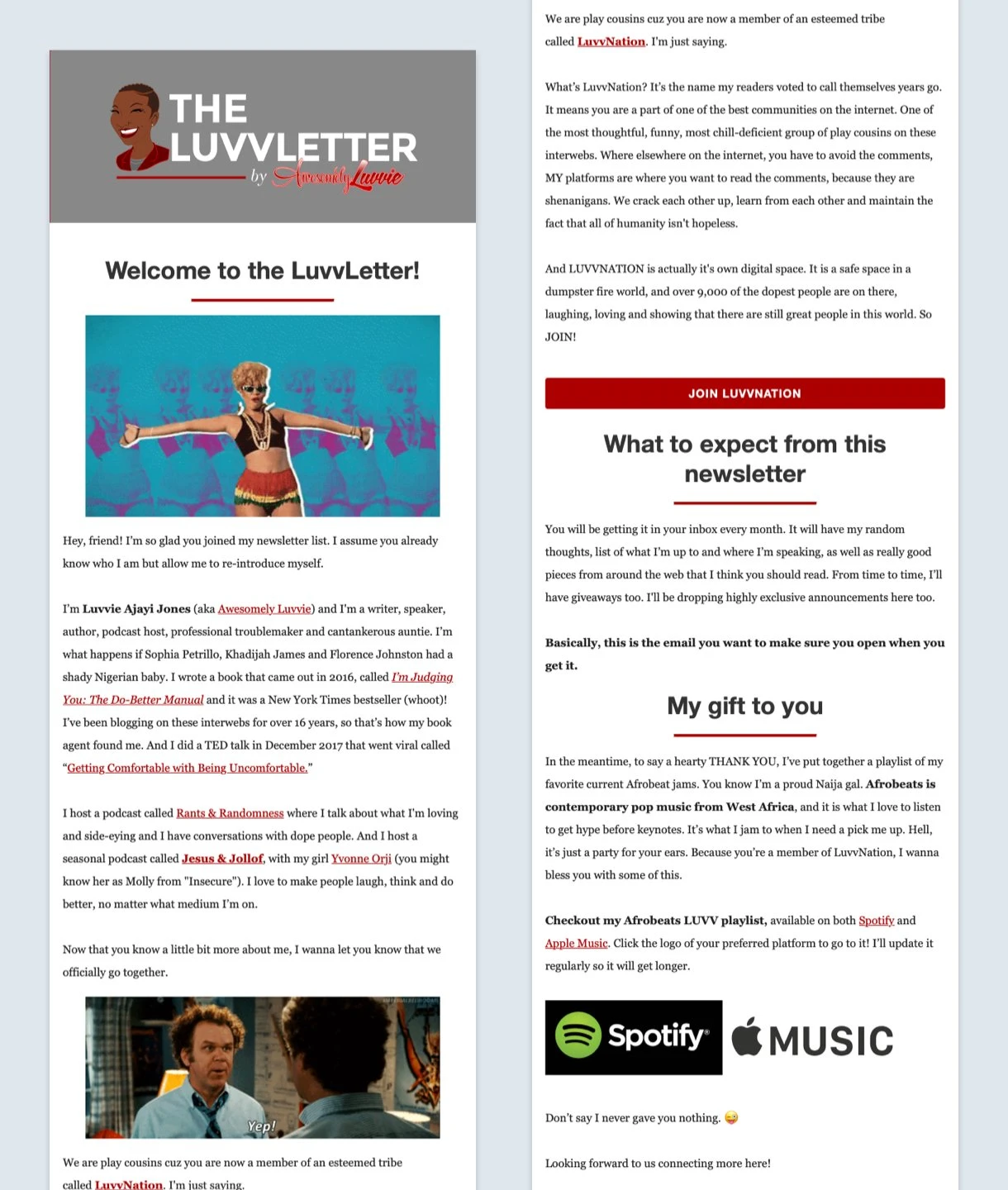
Learn more about welcome emails:
Marketing tip 2. Celebrate milestones
Did you get nominated for an award? Is it your birthday? Celebrate milestones with your listeners and use these events as an opportunity to boost engagement. For example, when celebrating your one-year podcast anniversary or 100th episode, ask readers to share their favorite episode.
By using an email tool that has interactive content blocks, you can stimulate dialogues and get closer to your audience. For example, MailerLite offers in-email survey blocks with which you can easily collect feedback or gather new ideas for future episodes.
Marketing tip 3. Segment your podcast audience
When you segment email subscribers with similar characteristics, it can help you send more targeted podcast campaigns. Email segments can be based on anything from behavior to interests.
You might host an event in a certain city and only invite people based there—not your entire email list. Or maybe you want to surprise loyal subscribers with a freebie or only ask long-term listeners to leave a review.
Bonus: Use personalization in your segmented email campaigns for even more power. Personalized content makes your emails feel even more one-on-one and targeted.
To recap today’s learnings
We hope that as a podcaster, this article gave you a glimpse of what email marketing can do for your small business. When listeners sign up for your email list, you can start talking directly to them, ask for ideas and feedback, and build a thriving community of loyal listeners. This makes email a powerful tool that can’t be missed in your podcast digital marketing strategy.
